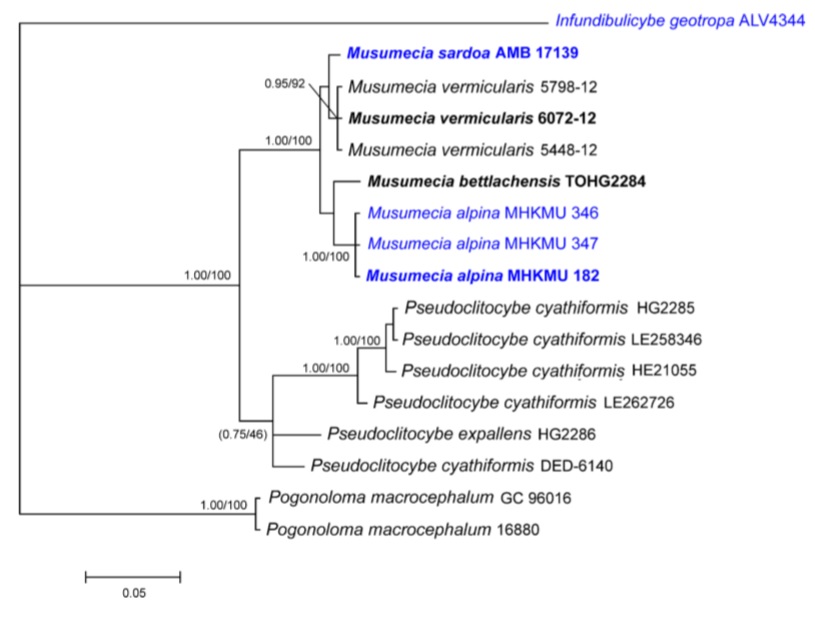Musumecia sardoa G. Consiglio, A. Vizzini & L. Setti
MycoBank number: MB 812779 Facesoffungi number: FoF 02047
Etymology: Derived from latin sardous, relative to the Sardinia, the region where it was first found.
Holotype: AMB n. 17139 Colour codes follow Kornerup and Wanscher (1981).
Habit mycenoid. Pileus 2–4 cm in diam., funnel shaped or infundibuliform, dark reddish brown (9E3, 10E3); surface pubescent; margin strongly involute; colour not changing when injured. Lamellae interspersed with lamellulae, decurrent, about 0.4–0.6 cm in width, rather broad, rather crowded, whitish cream. Stipe 3–5×0.8–1.5 cm, single, centrally attached to subcentral, subcylindrical to obclavate, slightly widening upwards, whitish cream to slightly brownish (5A2, 5C6); surface smooth; solid when young, becoming hollow or fistulose when mature; flesh fibrous, whitish cream (3A1, 2A1) or slightly brownish (5B3, 6B3). Odour faintly herbaceous. Spores [60/1/1] (5.8–) 5.9 –8.5 (–9.5)×(3.5–) 3.8 –4.2 (–4.9) μm, Q=(1.43–) 1.53 –2.00 (–2.17), Qm=1.76±0.18, long ellipsoid to cylindrical, sometimes dacryoid, with an apiculus up to 1μm, thin-walled, hyaline; containing small refractive droplets greenish in 5 % ammonia, cyanophilous in Cotton Blue; smooth; amyloid, in Melzer’s reagent the spore contour stains blackish blue, including the apiculus which stains more intensely. The basidiospores show a tendency to form tetrads. Basidia 25–32×6–8μm, subcylindrical to subclavate, hyaline, containing small droplets greenish in 5 % ammonia, thin-walled, 4-spored, sterigmata up to 5μm long; basidioles more or less cylindrical, rare septa with clamps at the base of basidia and basidioles. Hymenial cystidia absent. Hymenophoral trama subregular to irregular, composed by cylindrical hyphae, 3.5–10μm wide, hyaline, septate, sometimes the sept as lightly contracted, some hyphae with plates of encrusting parietal pigment. Subhymenium composed by short elements, 3–6 μm wide. Pileipellis made up of a thin layer of periclinal cylindrical hyphae, 4–10μm wide, slightly entangled, with rare septa, with an evenly grey cytoplasmic content and covered with plates of ochraceous parietal encrusting pigment. Scattered superficial hyphae forming small erect tufts and small more or less hemisphaerical warts. Stipitipellis composed by cylindrical, more or less parallel, septate hyphae with a pale ochraceous citoplasmatic pigment and small plates, 4.5–10μm wide, of parietal encrusting pigment. At the stipe apex short tufts of hyaline smooth septate hyphae, with a rounded and reclined apex. Thromboplerous hyphae present in pileipellis and stipitipellis, 3–7μm wide, with an evenly greenish yellow content. Context dextrinoid (more or less deep orange). Clamp-connections rare and scattered, present in subpellis and in pileitrama.
Habitat and known distribution: In coniferous forest, only known from Sardinia (Italy).
Material examined: ITALY, Sardinia, Desulo (NU), in a Pinus halepensis forest, 2 November 2004, leg. G. Consiglio, F. Franceschetti, A. Garbellotto & C. Orlandini (Herbarium AMB n. 17139, holotype).
Notes: Species in the genus Musumecia are characterized bytheir clitocyboid basidiomata, stipe more or less enlarged at the base, and more or less amyloid basidiospores. However, M. alpina has a dark grey, zonate, and fibrous-tomentose or pubescent pileus with the disc subumbonate in age, slightly larger basidiospores with granular decorations on the surface, often 2-spored basidia, and this species has cheilocystidia, pleurocystidia, and abundant clamps. Three European species have slightly larger basidiomata, shallowly depressed or infundibuliform or pileus in age, commonly 4-spored, smooth basidiospores without any decorations on the surface, absence of cheilocystidia and pleurocystidia. Additionally, there are no or rare clamp-connections in their basidiome. Musumecia bettlachensis has an ivory-white or cream-white glabrous pileus sometimes with a small umbo when young, somewhat smaller basidiospores (5.5–8.5×3.5–5μm), and lacks rhizomorphs (Vizzini et al. 2011). Musumecia sardoa has an infundibuliform, dark reddish brown, pubescent pileus, and amyloid spores. Musumecia vermicularis has an infundibuliform minutely tomentose pileus lacking umbo, and smaller basidiospores (6.5–7.5×3.5–5μm) (Musumeci 2014). The discovery of M. alpina in southwestern China suggests that Musumecia has a much wider geographical distribution ranging from East Asia to Europe. Musumecia alpina is here reported from an alpine region of southwestern China, growing in very different climate conditions.
Musumecia alpina and M. sardoa introduce some aberrant features for the genus: the first displays minutely ornamented spores, abundant clamp-connections, and hymenial cystidia; the second is characterized by its amyloid spores. As a matter of fact, the genus Musumecia shows a marked macro- and micromorphological heterogeneity while evident shared morphological features are currently unknown. Incontrast, its molecular homogeneity is very high and all Musumecia species so far known appear as a well supported monophyletic clade. Future work will be necessary to assess the presence of yet undescribed unifying morphological and/or physiological characters. To date, four taxa were reported in this genus. A key to the known species in Musumecia is provided above. Yunnan region is one of the major biodiversity hot spots in the world. Over 4000 species of fungi from different groups have been identified in this area during the last decades (Zhang et al. 2005; Li et al.2009, 2011b, 2014b; Yang et al. 2012, 2013, 2015; Zeng et al.2013, 2014; Hao et al. 2014; Songetal.2014; Tang et al.2014; Zhao et al.2014).Research is needed to confirm if this is a truly disjoint distribution or else there exist specimens of M. alpina or other related taxa in the intermediate regions of Central Asia.

Phylogenetic relationships of Musumecia based on ITS sequences data. Bayesian posterior probabilities (PP≥0.90) and RAxML bootstrap values (BP≥70 %) are shown above or below the branches. New taxa are in blue and ex-type specimens in bold

